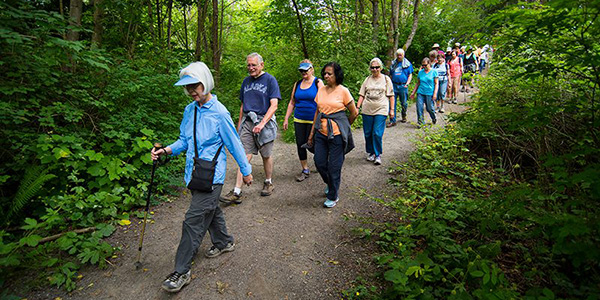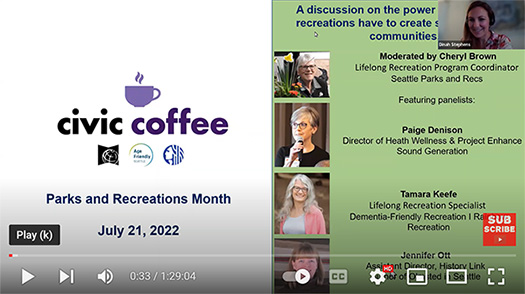Civic Coffee Recap: Parks and Recreation

Parks are at the center of so many experiences and memories. Our local parks often serve as our first experiences with nature, our introduction to a favorite hobby or physical activity, and gathering sites for celebrations with family and friends. They are the places we go to recharge ourselves, connect with others, and find respite from life’s stressors.
In recognition of National Parks and Recreation Month, this month’s Civic Coffee shined a spotlight on the important role that parks play in the lives of older adults. Our panelists shared their expertise as researchers, program administrators, and practitioners working with older adults. This article includes just some of their insights, so I encourage everyone to listen to the full discussion here.
Seattleites greatly benefit from our Olmstead Parks. Jennifer Ott, environmental historian and Assistant Director of HistoryLink, offered some perspective on the creation of this beloved park system. In 1903, when Seattle’s population was exploring after the gold rush, the Olmstead brothers came west to design the parks that we know and love today.
Rooted in a philosophy that parks are for everyone, the system was designed to include large parks connected by pathway circuits, plus smaller neighborhood parks where younger children can enjoy playgrounds and adolescents and adults can access playfields. The larger, flagship parks were intended to embrace their “genius of space”—that is, what makes that particular location special. Thanks to this approach, Seattle’s fantastic variety of views and ecology is on full display at parks offering sweeping views of the Cascades, quiet strolls through old growth trees, and beach access to Puget Sound.
While the Olmstead brothers never used the terminology “mental health,” they understood and advocated for the role parks can play in mental well-being. For instance, winding paths are intended to allow us to move through spaces naturally and intuitively, in contrast to the straight city sidewalks we are routinely jostled on. The brothers were concerned about the increasing number of hours people were spending inside at offices and factories and wanted parks to be an antidote to the effects of industrialization.
This rings true today: Paige Denison, Director of Health, Wellness & Project Enhance at Sound Generations, noted the many studies that show the value conducting our activities outside, whether that’s exercising, playing, or simply eating outdoors. In her experience working with evidence-based health promotion programs for older adults, she has seen parks as important places where people can healthfully manage their chronic conditions by enhancing their physical exercise and reducing depression (two things which are critical to preserving brain health—see last month’s Civic Coffee for more!).
An overwhelming majority of people in the U.S. believe they and their communities benefit from local parks. On average, people visit their local park and recreation facilities at least twice a month. During the isolating years of 2020 and 2021, parks played an especially important role: eighty-two percent of U.S. adults reported that visiting their local parks, trails and open spaces was essential for their mental and physical well-being.
Paige emphasized that the health benefits of parks should be available to all. However, not all communities have equal access to parks. July is also National Minority Mental Health Awareness Month, inviting us to reflect on the unique health challenges many people of color face, and our panelists stressed that is critical to recognize and address barriers—both visible and non—that prevent BIPOC and other marginalized people from receiving the full benefits of our parks. Parks should feel safe and welcoming to everyone. This can require an evaluation of current monuments and other elements that stigmatize certain people, as well as updating accessibility of paths and structures so that people of all abilities may enjoy them.
For some marginalized communities, tailored recreation programming can be especially life-affirming. Tamara Keefe manages Seattle’s Dementia-Friendly Recreation and Rainbow Recreation programs, offering unique activities catered to LGBTQ+ older adults and to people experiencing memory loss. She points out that older queer adults often have some shared lived history, and being around others who more readily understand us reduces the need to hide and creates room for joy. Similarly, strengths-based programming for people experiencing memory loss can counter the stigma of dementia. Honoring the unique journeys of diverse people is part of creating an inclusive environment where all people can reap the benefits of Seattle’s beautiful parks.
Seattle’s Parks and Recreation Department manages 6,441 acres encompassing 489 parks. This includes 25 miles of boulevards (many designed by the Olmstead brothers) and 120 miles of trails. Altogether, this accounts for about 12 percent of Seattle’s entire land area. For nearly 50 years, the department’s Lifelong Recreation program has been offering vibrant exercise, social, and arts programs to older adults. You can find activities near you by visiting Seattle Parks and Rec or Sound Steps to learn more about programs offered this summer and beyond—enjoy the outdoors!
 Contributor Dinah Stephens manages the Age Friendly Seattle initiative. She facilitated the June 23 Civic Coffee. Look for information about past and future Civic Coffees here. To join the Age Friendly Seattle distribution list, send a message to agefriendly@seattle.gov.
Contributor Dinah Stephens manages the Age Friendly Seattle initiative. She facilitated the June 23 Civic Coffee. Look for information about past and future Civic Coffees here. To join the Age Friendly Seattle distribution list, send a message to agefriendly@seattle.gov.
Photo credit: Lifelong Recreation hike photo at top by Cheryl Brown, Seattle Parks and Recreation.
![AgeWise King County [logo]](https://www.agewisekingcounty.org/wp-content/themes/agewisekingcounty/images/logo.png)
